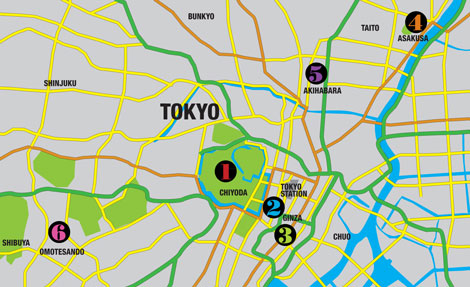Tom Otley maps out a whirlwind metro tour of the sprawling Japanese capital

1. Imperial Palace
Tokyo is a huge city (2,188 sq km) and, for the first-time visitor, initially daunting. The trick is to master the transport system, starting off with the subway and the JR (Japanese Railways) lines, particularly the Yamanote line, from which point the metropolis suddenly becomes far more manageable. This tour starts at one of its oldest spots – the Imperial Palace in the centre of the city. It takes its name from the fact this has been the home of the Japanese emperor since 1868, though Edo Castle occupied the area for centuries beforehand. The current emperor, Akihito, and his wife still live in the palace, though you are unlikely to spot them, not least since the general public are only allowed into the Imperial Palace Grounds on January 2 and December 23 (the emperor’s birthday), two dates universally unpopular for business travel. Still, depending on the weather, you can wander around the outer gardens, take pictures of Nijubashi bridge, and then head off towards the high rises for your whistle-stop tour of the city.
2. Marunouchi
Leave the Imperial Palace Gardens to the east and you’ll be in the shopping and business district of Marunouchi. An easy-on-the-eye introduction to Tokyo, this isn’t the neon bustling futureopolis that you may have been expecting, but long, straight streets filled with offices, the odd five-star hotel and international brand shops. For visiting bankers, it will be a home from home, but assuming you can resist the lure of the shopping, it’s the renovated Tokyo station (picture 2) you are heading for. It looks western, though apparently the guidebook story of it being modelled on Amsterdam’s Centraal station isn’t true – still, with the adjacent Tokyo Station hotel having been refurbished and reopened last year, you are seeing it in all its glory for the first time in decades.
Be exploratory, and enter the station via the hotel. Walk through the lobby and out into the station itself, then head to the metro (Tokyo) to buy tickets for the rest of this tour. Buy a pack of 11 coupon tickets (¥1,900/£13) to cover you for all metro journeys up to 11km. marunouchi.com/e/, thetokyostationhotel.jp, tokyometro.jp/en
3. Sony Building
Take the southbound Marunouchi line and get off at the next stop, Ginza station. The Sony building is a Tokyo landmark and, inside, the many staircases, bewildering layout and sheer volume of products on display – many of which are not yet for sale in Europe – make it a must-see. For anyone keen on electronics, its eight floors offer more than enough to while away an afternoon, and the fourth floor is the tax-free shopping zone. 531 Ginza; sonybuilding.jp
4. Asakusa
You’ve been to the geographical centre, now find the city’s real centre – the Senso-ji Temple in the Asakusa district. From Ginza station, take the northbound Ginza metro line to Asakusa station. The temple is a living, breathing place where rituals are still performed, and everyone from local students to old ladies comes to ask for good fortune.
Consider arranging a guide before your trip – Via Japan can help, and can provide simple instructions on how to negotiate the city, along with notes on what you are seeing. A guide will explain that holding opposites in dynamic tension is the Japanese way of doing things, hence the stunning juxtapositions of ancient and modern you will see in the city. The approach to the temple provides yet another contrast – small stalls selling traditional gifts and the ancient Kaminarimon Gate set against the backdrop of the striking Asakusa Culture Tourist Information Centre and Asahi building (pictured bottom left and right respectively). The latter’s design, by Philippe Starck, is a celebration of the beer, with the strange golden wave escaping from one side symbolising the Asahi flame.
5. Kotobukiya
If you have a pre-conceived notion of the Japanese having a strange affection for science fiction and fantasy dolls, Kotobukiya is the place to have those ideas confirmed. To reach it, hop back on the Ginza line and travel south, change at Ueno, and take the Hibiya line to Akihabara, Tokyo’s electronic district. The store has everything from Star Wars to Godzilla and Howl’s Moving Castle. Many are collector’s items, including painted resin Fine Art Statues, Bishoujo (pretty girl) Statues and One Coin Mini Figures. Step outside and check out the vending machines where you can pick up complete meals. kotoeu.com
6. Omotesando Hills
Take the Hibiya line back to Ueno, then take the Ginza line westwards to Shibuya, a couple of minutes’ walk from Omotesando Hills. High-end shopping malls aren’t in short supply in Tokyo, but this is something special. Japanese architect Tadao Ando’s design gets around the fact that the mall is on a hill with an ingenious series of ramps, escalators and stairs, which really enlivens the place. Shops include Escada, Black Fleece by Brooks Brothers, and Dolce and Gabbana. After dark, the façade acts as an LED advertisement. omotesandohills.com/english
Via Japan Holidays specialises in bespoke programmes to Japan for single travellers or small groups. Tel +44 (0)20 7484 3328; viajapan.co.uk








